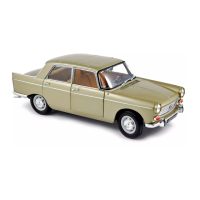-
4
Remove
the screws attaching the steering
gear
hous-
ing to the Íront crossmember.
5 Remove the nuts and serrated bolts
from
the wishbone
rubber bush attachments
to
the
crossmember
brackets
and
lower the
wishbone arms.
6 Remove the brake
pipe
attachment screws at the front
crossmemDer.
7
Remove the six screws attaching the crossmember to
the
side rails
and withdraw the Íront crossmember
from the car.
ReÍitting:
Refitting is the
reverse
procedure
but
note the
Íollowing
points:
1
When fitting the rear wishbone arms to the cross
member brackets, drive the serrated
pins
in
from
the
Íront,
up to the serrations
only.
2 Lower the front
of
the car
and
fit
a 31 mm thick block
between the
rebound
rubber and the crossmember,
3
Load the front
oÍ
the car until the
block
is held firmly.
4 Drive the
serrated
pins
Íully home,
tighten and lock
the retaining nuts.
5
Reconnect
the battery and check the front wheel
alrgnment.
8
: 10
Suspension
geometry
The
castor and camber
angles. the kingpin inclination
and the
wheel
alignment oÍ the
front
suspension
are
design settings
that have a very important eÍfect on the
handling oÍ the car. With the exception of
the front
wheel
toe-in,
all
the
settings
are determined
during
manufacture
and
no adjustment is
provided.
The
dimensions
for checking the
geometry
are
given
in
Technical
Data, but the use of specialized
equipment
is essential for accurate results and it is suggested that
these checks
be
leÍt to a fully equipped
Seríice
Station.
8 :11
Wheel
balancing
The need for wheel balancing has become
increasingly
pronounced
with
the use
oÍ
independent
suspension and
the light steering efforts designed
into modern
cars.
Wheel shimmy
(a
light tremor noticeable at the
steering wheel), or
wheel
wobble
(a
pronounced
tremor
noticeable at the steering
wheel,
caused
by
a selÍ-
sustained movement of
the road
wheels
to
the
left and
right
when moving
forward), can
both be due
to wheel
and tyre
out
of balance.
Although
in
some
cases
Íe-
positioning
the wheel relative to the hub may eÍÍect a
cure, the
onlv
accurate method to correct an out of
balance
force is
to use suitable
wheel
balancing
equip-
ment.
8
:12 Fault diagnosis
(a)
Wheel wobble
1
Worn
hub
bearings
2 Broken or weak
Íront
springs
3 Uneven tyre wear
4
Worn suspension
linkage
5 Loose wheel Íixings
(b)
'Bottoming'
oÍ suspension
1
Check 2in
(a\
2
Bebound rubbers
worn or
missing
3
Dampers
(shock
absorbers) not working
(c)
Heavy steering
1 Neglected swivel
pin
lubrication
2 Wrong suspension
geometry
(d)
Excessive tyre
wear
'1
Check
4 in
(a),3
in
(b)
and
2 in
(c)
(e)
Rattles
1
Check 2
in
(a)
2
Lubrication
neglected,
rubber
bushes worn
3
Damper
mountings
loose
4 Wishbone mountings
loose
or worn
(f
)
Excessive
rolling
1 Check
2 in
(a)
and 3
in
(b)
P404

